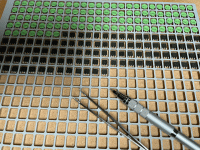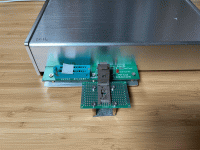Build a jig so you can just quickly clamp the JFET in place. One of those aluminum SMD PCBs for the Lovoltechs would be perfect if you build a fence around it so the JFET is the proper place without any fussing around.
Then use the circuit and procedure described by Mr. Pass in this thread, https://www.diyaudio.com/community/threads/jfet-matching.70788/, to sort the JFETs. With over 2500 transistors, this would be a good first step without having to spend a lot of time curve tracing.
Then use the circuit and procedure described by Mr. Pass in this thread, https://www.diyaudio.com/community/threads/jfet-matching.70788/, to sort the JFETs. With over 2500 transistors, this would be a good first step without having to spend a lot of time curve tracing.
It is a logistics problem, no simple solution.
We once had an idea to automate curve tracing.
But it was also a huge effort.
Patrick
We once had an idea to automate curve tracing.
But it was also a huge effort.
Patrick
I used my CNC to make trays for FET storage. Five trays each taking 24x24 FETs did it. Easy and free.
Placing the FETs in the slots, writing the labels and attaching these was a pain - and took time.....
For measurement I purchased a TO-252 test socket and fitted this to my trusted Locky_Z curve tracer.
Placing the FETs in the slots, writing the labels and attaching these was a pain - and took time.....
For measurement I purchased a TO-252 test socket and fitted this to my trusted Locky_Z curve tracer.
Attachments
I didn't know that TO-252 sockets existed. One would have been handy. I've been soldering my LD1014Ds to adapter PCBs before curve tracing. Still waiting for some more PCBs to continue my curve tracing efforts.
The loading/unloading of the FET is still what takes the longest time (some 20s with the FETs well organised in the trays). The devices nicely slip into place in the socket, but moving them around using forceps does take time.
The measurement itself takes 1-2s and is as simple as a click on the mouse. Data are automatically collected, numbered and saved.
Good music and interesting podcasts are your best friends.
The measurement itself takes 1-2s and is as simple as a click on the mouse. Data are automatically collected, numbered and saved.
Good music and interesting podcasts are your best friends.
The measurement itself takes 1-2s and is as simple as a click on the mouse.
Not how we do our curve tracing, if I may say.
We first allow a minimum of 10 minutes for each device on a temperature controlled heater block to get up to temperature.
For power amp output devices normally 55°C.
Then we clamp each power device with screw clamps onto the same heater block with Kerafol films as isolator.
After that , we run continuous waves for 5 minutes before logging the data.
That way, we believe, will make sure the matching corresponds to actual (class A) operating conditions.
Doing 2500 devices this way will take many weeks.
So the equipment has to be calibrated for consistency over such time frame.
Patrick
Your way is certainly the best if you know the exact actual operating conditions beforehand. I don't.
My experience tells me that devices that traces similarly at one defined condition also behave similarly under different conditions.
Later on I may still need to do measurement at operating conditions (if I need perfect matches), but on a dramatically lower number of devices.
With 2500+ devices to do, most data with least effort is what I'm looking for.
My experience tells me that devices that traces similarly at one defined condition also behave similarly under different conditions.
Later on I may still need to do measurement at operating conditions (if I need perfect matches), but on a dramatically lower number of devices.
With 2500+ devices to do, most data with least effort is what I'm looking for.
- Home
- Design & Build
- Parts
- Curve tracing LD1014D/LU1014D

